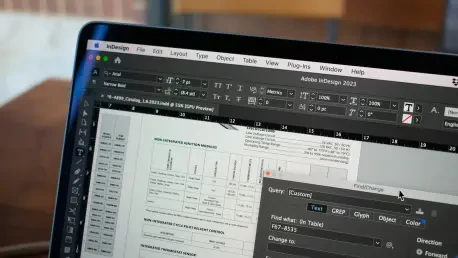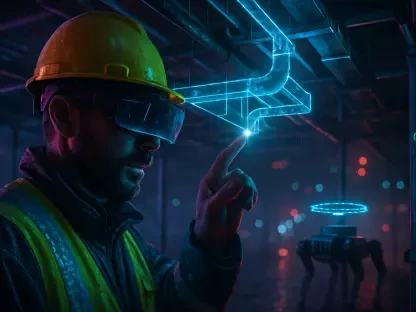The backdrop of today’s digital age is witnessing an exceptional convergence of artificial intelligence and building information modeling (BIM) software, signaling a profound shift in how industries approach design and simulation tasks. With technological advancements reshaping traditional methodologies, businesses are reevaluating strategies to integrate AI into their operations effectively. Siemens Realize Live Americas 2025 emerges as a pivotal event reflecting this trend, highlighting cutting-edge innovations in BIM and design software. The concurrent rise of Arcol’s cloud-based BIM platform further illustrates the compelling narrative of digital evolution, underscoring the strategic direction pioneers in the sector are adopting.
Unveiling Siemens Realize Live Americas 2025
Pioneering Technologies and Philosophical Insights
Held in Detroit, Siemens Realize Live Americas 2025 captivated the attention of over 2,500 attendees at the Huntington Place Convention Center. Siemens Digital Industries Software CEO Tony Hemmelgarn laid the foundation for the conference with a philosophical narrative inspired by Heraclitus, likening the digital age’s dynamic nature to constant change. Hemmelgarn articulated Siemens’ growth strategies, emphasizing the Xcelerator portfolio’s directional thrust and its seamless integration within the company’s wider ecosystem. At the core of Siemens’ showcase was a focus on AI copilots within Teamcenter and NX CAM. These tools exemplify how Siemens leverages artificial intelligence to foster user interaction, empowering engineers and designers to push creative boundaries.
Siemens’ exhibition introduced transformative tools designed to streamline design and manufacturing workflows, among which the Teamcenter Digital Reality Viewer garnered significant attention for its immersive approach to engineering visualization. Siemens’ strategic depth is further illustrated through acquisitions such as Altair and Dotmatics, broadening the ambit of its modeling and data management capabilities. The collaborations with leaders like Rolls Royce underline Siemens’ commitment to delivering comprehensive solutions across high-tech industries. Collectively, these initiatives highlight how Siemens is not only embracing innovation but actively shaping the future landscape of engineering software.
Advanced Software and AI Implementations
Joe Bohman, executive vice president of PLM products at Siemens, further expanded on the technological innovations during a keynote address. He delved into specific functionalities of Siemens’ product suite, particularly in the realms of product design and management. Paramount to this discussion was the Bill of Materials (BOMs), a staple in product engineering, enriched by enhancements through Simcenter HEEDS. The address also spotlighted advancements in electrical design via Siemens Capital and requirements management through Polarion. A noteworthy mention was Siemens’ venture into developing an “industrial foundation model,” which seeks to enhance AI’s efficacy by contextualizing engineering language.
Siemens is striving to augment user experience by refining software interfaces and embedding AI agents. Such updates promise swift task execution and simplified user interaction. Additionally, Siemens unveiled a rebranded vision for its CAD tools, dubbed “Siemens Designcenter,” which integrates Solid Edge and NX functionalities. Enhancements to NX CAD now allow for simultaneous collaborative editing—reminiscent of Google Docs’ capabilities—thus bolstering teamwork and fostering a collaborative ethos in engineering endeavors. These innovations underscore Siemens’ commitment to deploying AI solutions that resonate with modern user demands.
Arcol’s Innovative Leap in the BIM Arena
A New Paradigm in BIM Software
Parallel to Siemens’ strides, Arcol, a promising startup from New York, introduced a web-based platform poised to redefine the BIM landscape. Dubbed the “Figma for BIM,” this platform heralds a new era for architects, engineers, and construction professionals seeking an intuitive and streamlined design experience. Paul O’Carroll, founder and CEO, highlighted the platform’s user-friendly design, aiming to eliminate traditional challenges like version control and cumbersome file dependencies. Drawing inspiration from Figma’s success, Arcol presents a real-time, web-first ecosystem promising collaborative and efficient processes.
Arcol’s tools enable geometric modeling, automated calculations, and offer an interactive presentation suite known as Boards. These innovations harmonize user propositions and ensure synchronization across deliverables. Export functionality in formats like STL and JPEG, alongside a Revit add-in, affirms Arcol’s readiness to interface seamlessly with established Autodesk products. With an ambitious goal to expand from conceptual design to construction documentation, Arcol is establishing itself as a key player in the evolving BIM landscape. Its strategic pricing model, beginning at $100 monthly per user, thoughtfully caters to both individual and enterprise users.
Challenging the Status Quo in BIM Models
The emergence of Arcol is reminiscent of Motif, another cloud-based BIM platform that debuted recently. Both platforms embark on a mission to challenge and disrupt existing BIM conventions dominated by conglomerates like Revit. With an emphasis on real-time collaboration and web-based access, both platforms share a vision powered by strategic investments from industry stalwarts, such as former Autodesk co-CEO Amar Hanspal. Arcol’s innovations not only reflect a deviation from traditional methods but also signify a larger industry momentum toward embracing change.
The momentum behind Arcol and platforms like it underscores the digital transformation narrative gaining traction within the design and engineering software landscape. By prioritizing interactivity, flexibility, and heightened user experience, these platforms are leading a change-driven dialogue about the future. As industries gravitate toward more adaptable and innovative solutions, AI-driven tools and collaborative functions become central to this endeavor, pushing the boundaries of conventional software paradigms and heralding a new chapter in technological advancement.
New Horizons in Design and Engineering
In today’s digital era, a remarkable convergence between artificial intelligence (AI) and building information modeling (BIM) software is reshaping how industries tackle design and simulation tasks. This merging signals a significant transformation in traditional methodologies, prompting businesses to rethink and restructure their strategies to incorporate AI effectively into their operations. Siemens Realize Live Americas 2025 stands out as a crucial event highlighting this shift, focusing on groundbreaking innovations in BIM and design software. It is a showcase of the latest trends and revolutions reshaping the industry. Simultaneously, the emergence of Arcol’s cloud-based BIM platform demonstrates the ongoing digital evolution, offering a clear example of the strategic directions adopted by leaders in the sector. This synergy between AI and BIM is important, driving the adoption of new technologies that promise to enhance efficiency and creativity in design, propelling the industry into a future where digital integration plays a core role in shaping architectural and engineering solutions.









